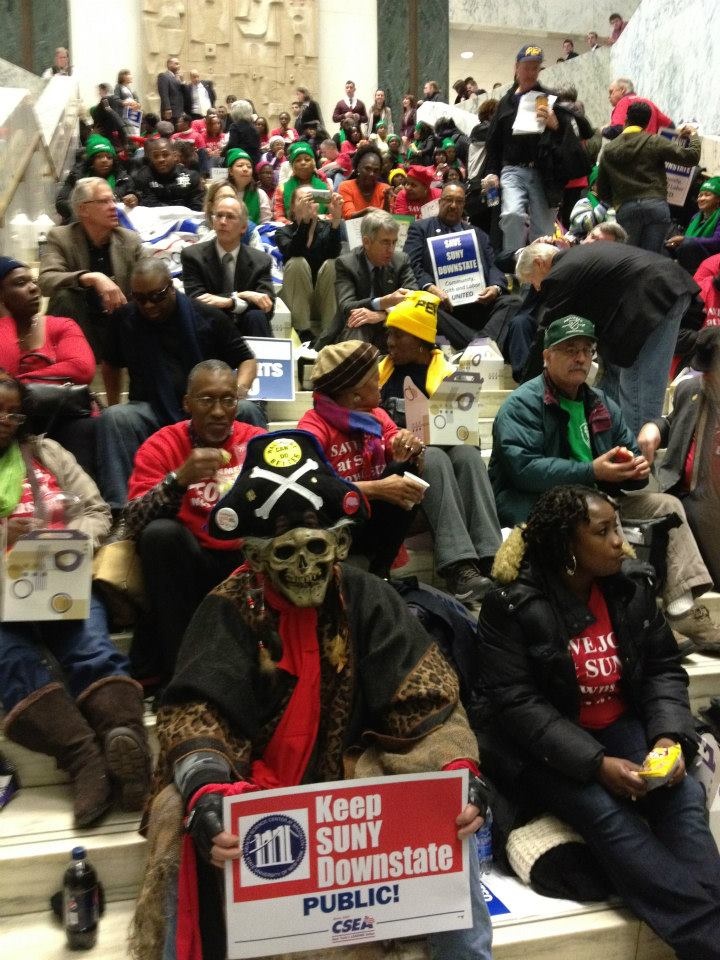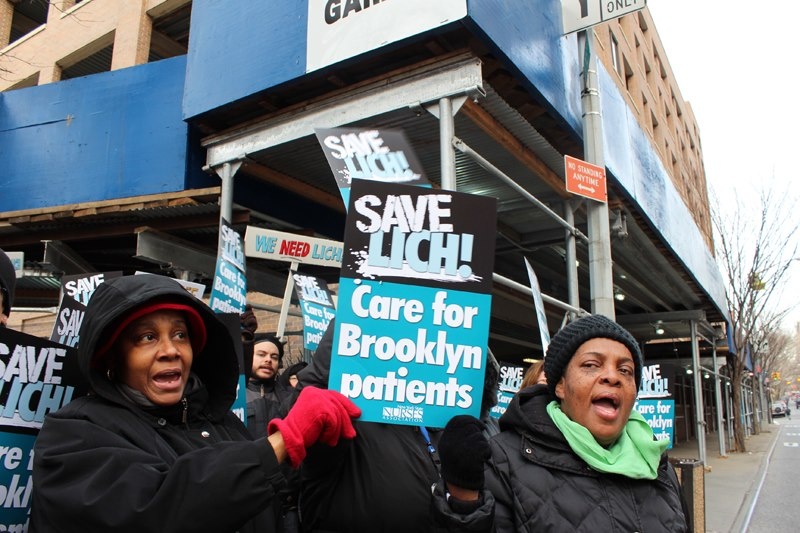Members of the New York State Nurses Association rally, ahead of a meeting held by the State Assembly’s Healthcare Committee in downtown Brooklyn.
Susan Raboy, a 40-year resident of Brooklyn Heights, awoke from a nap on August 12, 2011, in excruciating pain. “It turns out I had a severely ruptured colon and sepsis throughout my body,” she siad. Emergency responders rushed the senior citizen to Long Island College Hospital (LICH), whose physicians knew her well. Raboy remembers little of her three-month stay at the hospital where she was treated for a severe case of septic arthritis, but one drug-induced dream sticks out.
Videos by VICE
Dr. Daniel Ricciardi, her arthropathy specialist, arrived at her bedside via an airplane to hold her hand. “It turns out that he was there,” Raboy said. As she learned later, “It wasn’t his case, but he came every day to sit with me. LICH doctors care so much about their patients.” Raboy credited the care she received at LICH with saving her life and said she doesn’t know if she would have survived a trip to another hospital.
Last month, trustees with the State University of New York (SUNY), which runs the 155-year-old institution, voted to close its doors, citing a budget deficit ballooning at the rate of a million dollars a week. Public input was solicited at the meeting where the Board of Trustees pronounced their judgment on the hospital, but the vote was held outside the city in Purpose, New York—far from LICH’s patients, who have rallied side by side with caregivers to keep the hospital open.

Proponents of saving LICH gathered at the vote held by SUNY’s Board of Trustees last month in Purpose, New York.
In a press release, SUNY described the closing as a “difficult but necessary step” taken to “stabilize the finances” of its Downstate Medical Center.
On Monday, Justice John Lee Baynes of Brooklyn’s Supreme Court sided with patients and staff at LICH who are mounting a legal challenge in defense of the hospital. Judge Baynes issued a temporary restraining order that bars the state’s Department of Health from reviewing SUNY’s closure plans until a May 2 hearing. He described SUNY’s outline for shutting the hospital down as “arbitrary and capricious, an abuse of discretion and a violation of lawful procedure.”
Should SUNY clear the legal hurdles before it, the Health Department will then weigh the impact that the hospital’s vacancy could have on the city’s institutional healthcare network.
“LICH is part of a hospital healthcare system,” said Skipp Roseboro, who is on the executive board of New York Communities for Change, a local advocacy group that is fighting to preserve the care center. “When you have a system, you strategically locate hospitals in different parts of the city so that they support the population. Each hospital supports the other hospital and so on. The fact that we’ve lost so many hospitals already has weakened that system.”
Among hospitals in the city’s network that have already been shuttered, there’s St. Vincent’s. Closed in 2010, it’s now a punching bag for a wrecking ball. Luxury apartments are slated to occupy the space where the hospital once stood, while no replacement has sprouted up to provide care for the tens of thousands of patients it once served in Lower Manhattan. Like St. Vincent’s, LICH sits on high-value real estate, and critics charge it could go the same way.
Nationally, not-for-profit hospitals are having a hard time since Wall Street crashed the economy. State- and federal-tax revenues have declined, biting into healthcare subsidies. Where real estate agents aren’t auctioning off hospital property, for-profit companies are taking them over. In 2010, the hedge fund Blackstone Group bought up eight hospitals in recession-rattled Detroit, while Cerberus Capital Management gobbled up six Catholic hospitals in Boston. The number of US medical centers that are now investor owned has risen gradually but steadily since 2006 at a rate of about 1 percent a year according to a review of American Hospital Association data by the trade journal Modern Healthcare.
Charles “Chip” Khan, who is the president of Federation of American Hospitals, a lobby group representing investor-run hospital chains, estimates one in five US hospitals in the US currently run on a for-profit basis. He expects that figure will reach one in four in the coming years should the current trend of buyouts continue. “We see time and time again our companies—whether it’s in the rural United States or in an urban setting—come in when hospitals need better management and need capital to expand and keep their services up to the highest-quality standards.”
According to Khan the for-profit model provides caregiving institutions with an incentive to provide quality and efficient patient care. “In the American economy, if you don’t serve the consumer, you’re not going to succeed,” he said. “An institution that does a good job serving the consumer and runs that institution efficiently will hopefully make a margin.”
But sometimes, making a margin is at odds with treatment. In an exposé last summer, the New York Times documented ways in which the nation’s largest for-profit chain has sacrificed patients on the alter of profit, while leeching out medicare and medicaid payments from taxpayers that are well above the industry average. The Hospital Corporation of America (HCA) was taken over by Bain Capital Management, former Republican presidential candidate Mitt Romney’s old firm, along with Kohlberg Kravis Roberts and Merrill Lynch (now Bank of America) in 2006.
While the profits investors reaped through the buyout set the path for Wall Street to get into the hospital game, the changes in billing and treatment practices that ensued at HCA under their new hedge fund overseers provide an example of what hospital treatment in the future could look like, if monied interests keeping jumping in the mix. HCA facilities laid off staff or else cut their hours. Bedsores, which arise when immobile patients are not turned over and serve as an industry indicator of treatment quality, began to increasingly pustulate on HCA patients, caregivers disclosed to the Times.
HCA had a checkered past even before Bain and others took over. The corporation had been forced to pay out $1.7 billion to the federal government over a Medicare fraud scheme in the 90s. As part of a corporate-integrity agreement HCA reached with regulators in order to stay in business, an independent reviewer scrutinized the hospital chain’s applications for Medicare reimbursement. Just when that agreement came to an end in 2008, the hospital changed its billing classifications. Medicare payouts skyrocketed. At Riverside Community Hospital in California, they leapt from $48,000 in revenue in 2006 to $949,000 in 2010. The Times noted that, “Nearly overnight, HCA’s patients appeared to be much, much sicker.”

Supporters of keeping LICH open rally outside the hospital, January 2013.
Some patients, that is. The chain also instructed its admissions staff to determine whether the ailments of those seeking treatment were life threatening. If not, they were told to pay up in advance or were shown the door. In 2009, a patient with an artificial heart valve complaining of a fever was 86’d from HCA’s Northside Hospital in St. Petersburg, Florida, only to die of related respiratory problems three days later. HCA eventually paid $38,000 in fines to the Department of Health and Human Services. Meanwhile, no action has been taken against HCA over its billing practices and a former executive with the corporation, Marilyn Tavenner, is currently acting administrator of the government’s Medicare and Medicaid programs. The expansion of Medicaid coverage scheduled for 2014 under the Affordable Care Act, could offer HCA—along with those in the industry following their lead—a fresh pool of patients to cover bill.
“Having a for-profit model of care,” said Sean Petty, a representative with the New York State Nurses Association and a practicing nurse, “means that you’re taking a chunk of money that people pay into the system—whether that’s through their insurance companies, whether its out of their pockets, whether it’s with Medicaid and Medicare—and its going into the hands of Wall Street speculators, bankers, or a board of directors. That’s money that does not go to patients directly.”
New York law stipulates that investors in for-profit hospitals must be “natural persons,” effectively keeping corporations and equity firms from buying up the state’s medical centers. Nonetheless, Petty said corporations have begun creeping their way into the state’s medical system, observing that kidney-dialysis services in New York City hospitals are gradually being outsourced to for-profit outfits.
A proposal tucked within Governor Andrew Cuomo’s 2013–2014 legislative budget would have suspended New York law to allow corporations to run two pilot hospitals in the state, opening New York’s doors to the likes of HCA. Due to public outcry, the proposal was crossed out of the final budget approved by lawmakers, putting a damper on plans to expand the market for those seeking to profit off of patients’ ailments… for now.
Either way, critics contend, adding the greenback motive to care won’t necessarily be a medical center’s salvation. Residents of Brooklyn’s Bedford-Stuyvesant neighborhood are bracing themselves for service cuts at Interface Hospital. Corbett Price, a former HCA executive who served as CEO and sole shareholder of the for-profit firm managing the hospital, took it to bankruptcy court earlier this year. Price doesn’t seem to see himself as a negative example, telling Crains recently, “New York should allow investor-owned companies to come in,” since, “access to capital continues to be a problem.”
That hospitals in New York and across the country lack funds to expand and even sustain themselves is an assertion few would find contentious. Still, the question remains whether funds could be raised through taxing Wall Street or allowing them to buy out America’s healthcare system.
More about Healthcare:
Fillibustin’ with Willie D – My Healthcare Reform Plan
Republicantics – The Healthcare Guide for People Who Don’t Want Healthcare